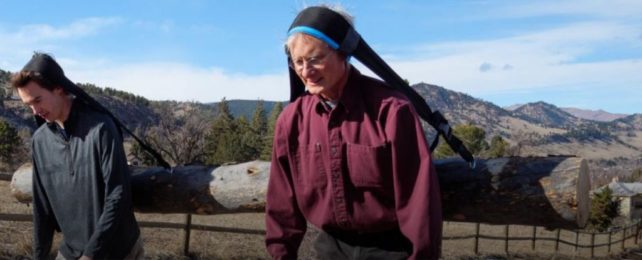High up on the Colorado Plateau, in what is today the state of New Mexico, sit the remains of what was once a city of epic proportions.
From the 9th to the 12th century CE, the tens of thousands of ancestral Puebloan people who lived in Chaco Canyon occupied massive buildings stretching up to four stories high, many of which feature hundreds of rooms.
Made from sandstone blocks and heavy timbers, the buildings in and around Chaco Canyon were the largest structures ever built in North America prior to the 19th century. And yet without the assistance of wheels or draft animals, the transport of such massive pieces of material from nearby mountains would have been a challenge many find hard to imagine.
Researchers at Colorado University (CU), Boulder have now put their heads together to figure out the mystery… quite literally.
The team showed the human skull, neck, and spine are more than capable of acting together to support a 60-kilogram (130-pound) wooden beam 100 kilometers (60 miles) or more.
All that's required to schlep this impressive load is a pair of willing humans, a couple of head straps, and a bit of determination.
"Some people baked sourdough bread during COVID. Instead, we carried sand and heavy logs around using our heads," laughs Rodger Kram, an integrative physiologist at CU Boulder.
In today's world, where backpacks are ubiquitous, you might be wondering how scientists settled on head-packs for such heavy timber loads.
At first, Kram and two of the study's co-authors, neurophysiologist Joseph Carzoli and biochemist James Wilson, tried to heft the logs on their shoulders, but they quickly came to realize how inefficient that was.
"It was just debilitating," Kram recalls. "It's just a dumb way to carry a heavy object."
Humans have known that for millennia, yet today, this ancient hack is too often overlooked. Waist straps are instead regularly attached to hiking backpacks to help give our shoulders a break and redistribute some of the weight to our core.
A much easier option, as it turns out, is to strap the weight to the top of your head using a tumpline.
Tumplines are simple tools with ancient roots that have been used around the world for millennia.
In and around Chaco Canyon, archaeologists have found ceramic effigies illustrating Puebloan people using tumplines to carry resources, as well as yucca fiber wraps that could be the remains of ancient tumplines.
The authors mention that sherpas in Nepal still use tumplines to carry loads as heavy as 111 kilograms, all the while guiding tourists whose shoulders are likely burning with much lighter packs.
"Tumplines allow one to carry heavier weights over larger distances without getting fatigued," explains Wilson.
After months of practice, under the guidance of Carzoli, Wilson and Kram could work together to transport a 60-kilogram ponderosa pine up and down a hilly road at a rate of about 25 kilometers a day.
That's not much slower than a burden-less walking pace, and researchers say it was achieved with "surprising" comfort.
"Based on our test of concept, we conclude that it is entirely feasible that Chacoans could have used tumplines to transport heavy timbers," the authors write.
Perhaps that is why the ancient roads that lead to Chaco Canyon are as wide as 9 meters, allowing for heavy timber to be carried horizontally by a line of workers, each strapped in by their foreheads.
"Verbal communication between subjects was critical for properly timing of the lifting and timber positioning movements," Kram and his colleagues write.
"Subjects quickly learned to "walk in step" to mitigate timber swaying and loss of control."
The determined scientists also carried T-shaped sticks to lean the timber against when they took breaks – that way they didn't need to constantly load and unload the tumplines. They got this idea from sherpas in Nepal.
Based on their efforts, the team estimates three humans could feasibly carry an 85-kilogram timber roof beam from the forests of the Chuska Mountains down to the Chaco desert. The trip would take about four days in total, with time for rest and refueling.
It's estimated that something like 200,000 timber beams would be needed to build the entire city. That's no small amount of work, but a task that now seems feasible with enough time and human resources.
Who made this arduous journey is unclear, but since mountains are sacred places in descendant Pueblo society, researchers think the trip could have been a ceremonial act, designed to inspire teamwork, cohesion, trust, and faith.
There is also the possibility that slaves were employed to build the great houses of Chaco Canyon, as some oral traditions have it.
"We lack definitive evidence that tumplines were actually used to transport timbers to Chaco," the scientists admit, "but we have demonstrated that this method would have been highly effective."
The next step, researchers say, is to conduct a modern re-enactment of the entire trip to see if it is, in fact, possible.
The study was published in the Journal of Archaeological Science Reports.
